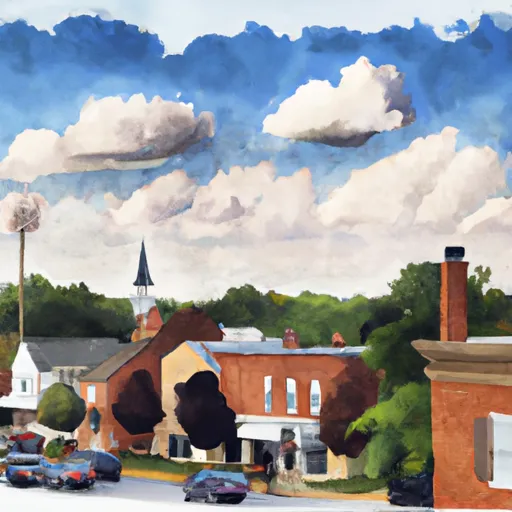-
 Snoflo Premium
Snoflo Premium
Get unlimited access to all our content
With no Ad interruptions! - Start Your Free Trial Login with existing account
Zionsville
Eden Index
Climate
8.1
•
Recreation
2.8
•
Community
7.5
•
Safeguard
6.1/10

Zionsville, Indiana, a charming town located just northwest of Indianapolis, offers a pleasant climate and numerous outdoor recreational opportunities. The town experiences four distinct seasons, with warm summers and cold winters. Average high temperatures in summer range from 80-85°F, while winter sees average highs around 35-40°F. Spring and fall bring mild temperatures and beautiful foliage.
Hydrologically, Zionsville is situated in Boone County, which is part of the White River watershed. The town's water supply comes from underground wells, providing residents with clean and reliable drinking water.
Zionsville boasts a variety of outdoor recreational activities. The town features a well-maintained system of parks and trails, perfect for hiking, biking, and enjoying nature. The famous Zionsville Rail Trail provides a scenic path for pedestrians and cyclists to explore the area's picturesque landscapes. Additionally, golf enthusiasts can indulge in the challenging courses at the nearby Golf Club of Indiana.
For water lovers, Zionsville offers opportunities for canoeing and kayaking on the nearby Eagle Creek Reservoir. Fishing enthusiasts can cast their lines into the reservoir or nearby rivers, such as the White River, to catch bass, catfish, and more.
In summary, Zionsville, Indiana enjoys a pleasant climate with distinct seasons. Its hydrology primarily relies on underground wells, ensuring a reliable water supply. The town provides ample outdoor recreation opportunities, including hiking, biking, golfing, and water activities, making it an ideal destination for nature enthusiasts and adventure seekers.
What is the Eden Index?
The Snoflo Eden Index serves as a comprehensive rating system for regions, evaluating their desirability through a holistic assessment of climate health, outdoor recreation opportunities, and natural disaster risk, acknowledging the profound impact of these factors on livability and well-being.
Climate Health Indicator (CHI): 8.1
Zionsville receives approximately
1072mm of rain per year,
with humidity levels near 82%
and air temperatures averaging around
11°C.
Zionsville has a plant hardyness factor of
5, meaning
plants and agriculture in this region thrive during a short period during spring and early summer. Most
plants will die off during the colder winter months.
By considering the ideal temperature range, reliable water supplies, clean air, and stable seasonal rain or snowpacks, the Climate Health Indicator (CHI) underscores the significance of a healthy climate as the foundation for quality living.
A healthy climate is paramount for ensuring a high quality of life and livability in a region, fostering both physical well-being and environmental harmony. This can be characterized by ideal temperatures, reliable access to water supplies, clean air, and consistent seasonal rain or snowpacks.
Weather Forecast
Streamflow Conditions
Patoka-White
Area Rivers
Patoka-White
Snowpack Depths
Patoka-White
Reservoir Storage Capacity
Patoka-White
Groundwater Levels
Recreational Opportunity Index (ROI): 2.8
The Recreational Opportunity Index (ROI) recognizes the value of outdoor recreational options, such as parks, hiking trails, camping sites, and fishing spots, while acknowledging that climate plays a pivotal role in ensuring the comfort and consistency of these experiences.
Access to outdoor recreational opportunities, encompassing activities such as parks, hiking, camping, and fishing, is crucial for overall well-being, and the climate plays a pivotal role in enabling and enhancing these experiences, ensuring that individuals can engage in nature-based activities comfortably and consistently.
Camping Areas
| Campground | Campsites | Reservations | Toilets | Showers | Elevation |
|---|---|---|---|---|---|
| Brown County State Park | 430 | 899 ft | |||
| Walnut Creek Marina | 33 | 608 ft | |||
| Starve Hollow State Rec Area | 200 | 552 ft | |||
| Sycamore Springs Park | None | 490 ft | |||
| Hardin Ridge | 200 | 780 ft | |||
| Buffalo Trace Co Park | 64 | 803 ft | |||
| Paynetown State Rec Area - Monroe Lake | 320 | 557 ft | |||
| Spring Mill State Park | 220 | 670 ft | |||
| Yellowwood State Forest | 80 | 613 ft | |||
| OBannon Woods State Park | 280 | 784 ft |
Nearby Ski Areas
Catastrophe Safeguard Index (CSI):
The Catastrophe Safeguard Index (CSI) recognizes that natural disaster risk, encompassing floods, fires, hurricanes, and tornadoes, can drastically affect safety and the overall appeal of an area.
The level of natural disaster risk in a region significantly affects safety and the overall livability, with climate change amplifying these risks by potentially increasing the frequency and intensity of events like floods, fires, hurricanes, and tornadoes, thereby posing substantial challenges to community resilience and well-being.
Community Resilience Indicator (CRI): 7.5
The Community Resilience Indicator (CRI) recognizes that education, healthcare, and socioeconomics are crucial to the well-being of a region. The CRI acknowledges the profound impact of these elements on residents' overall quality of life. By evaluating educational resources, healthcare accessibility, and economic inclusivity, the index captures the essential aspects that contribute to a thriving community, fostering resident satisfaction, equity, and social cohesion.

